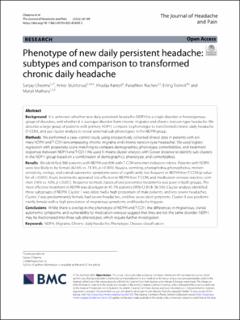| dc.description.abstract | Background
It is unknown whether new daily persistent headache (NDPH) is a single disorder or heterogenous group of disorders, and whether it is a unique disorder from chronic migraine and chronic tension-type headache. We describe a large group of patients with primary NDPH, compare its phenotype to transformed chronic daily headache (T-CDH), and use cluster analysis to reveal potential sub-phenotypes in the NDPH group.
Methods
We performed a case–control study using prospectively collected clinical data in patients with primary NDPH and T-CDH (encompassing chronic migraine and chronic tension-type headache). We used logistic regression with propensity score matching to compare demographics, phenotype, comorbidities, and treatment responses between NDPH and T-CDH. We used K-means cluster analysis with Gower distance to identify sub-clusters in the NDPH group based on a combination of demographics, phenotype, and comorbidities.
Results
We identified 366 patients with NDPH and 696 with T-CDH who met inclusion criteria. Patients with NDPH were less likely to be female (62.6% vs. 73.3%, p < 0.001). Nausea, vomiting, photophobia, phonophobia, motion sensitivity, vertigo, and cranial autonomic symptoms were all significantly less frequent in NDPH than T-CDH (p value for all < 0.001). Acute treatments appeared less effective in NDPH than T-CDH, and medication overuse was less common (16% vs. 42%, p < 0.001). Response to most classes of oral preventive treatments was poor in both groups. The most effective treatment in NDPH was doselupin in 45.7% patients (95% CI 34.8–56.5%). Cluster analysis identified three subgroups of NDPH. Cluster 1 was older, had a high proportion of male patients, and less severe headaches. Cluster 2 was predominantly female, had severe headaches, and few associated symptoms. Cluster 3 was predominantly female with a high prevalence of migrainous symptoms and headache triggers.
Conclusions
Whilst there is overlap in the phenotype of NDPH and T-CDH, the differences in migrainous, cranial autonomic symptoms, and vulnerability to medication overuse suggest that they are not the same disorder. NDPH may be fractionated into three sub-phenotypes, which require further investigation. | en_US |

